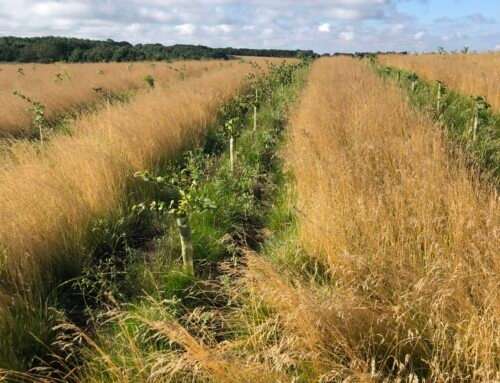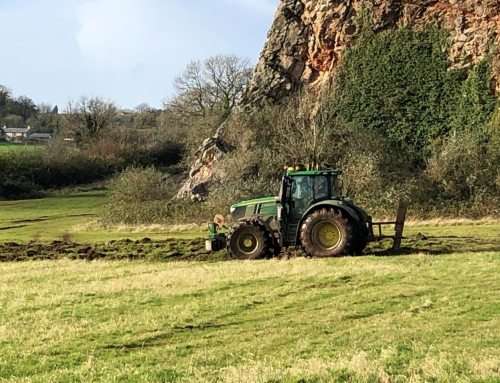Woodland Creation – Swadlincote
Site: Swadlincote, Derbyshire
Client: Mountpark Developments Ltd
Departments Involved: Forestry

Overview
Mountparks’ visionary project transformed 23ha of arable land into a multi-purpose woodland, aligning with government environmental policies. The goals encompassed carbon sequestration, biodiversity enhancement and community well-being. Despite challenges, thorough planning ensured less than 7% failure of trees during establishment. Carbon calculations estimate an impressive 4,850 tonnes of carbon sequestration over the first century.
The project incorporates native trees, parkland areas and access networks for a diverse and accessible woodland. Registered on the Woodland Carbon Code, it stands as a beacon of sustainable environmental practices with ongoing community engagement
Highlights
Multifunctional Woodland Design:
- A collaborative effort with Mountpark to design a diverse woodland with various habitats.
- Extensive network of rides with highlighted viewpoints.
- A comprehensive soil analysis was conducted before sowing wildflowers to guide the design.
- Inclusion of wet woodland, wetland scrapes and diverse wildflowers.
Project Execution:
- The project started in the spring of 2022 with careful specification, tendering and supervision by the team.
- Excellent tree establishment with less than 7% failures despite challenging weather conditions.
Carbon Sequestration and Monitoring:
- Woodland registered on the Woodland Carbon Code with an estimated 4,850 tonnes of carbon sequestration over 100 years.
Community Engagement:
- Community events and interpretation signage to ensure community engagement and ownership.
- Collaborative efforts with the National Forest for further community events.


Context
Mountpark appreciated the increased focus on government environmental policies and wanted an environmentally focused project to learn from, for themselves and their partners. To begin this project, Mountpark purchased 23ha of low-grade arable land in Swadlincote, Derbyshire. The site is situated on the edge of a village, an excellent location to benefit the community.
The objectives of the project were to create a multi-functional woodland called St. Peters Wood with public access. Benefits of the woodland would be carbon sequestration, biodiversity enrichment and improvements to the health and well-being of local communities. The design included the aim of planting 27,500 native broadleaf and coniferous trees and shrubs, with a network of access tracks and rides.
Challenges
Past and present challenges:
- The project faced weather challenges due to hot weather conditions. Drought conditions can impact a tree’s chance of survival. Nonetheless, in this project tree survival rate was exceptional, likely from the good establishment of trees and north-facing land.
Future challenges:
- The site aimed to have a variety of habitats and species diversity. Maintaining wet woodland and wetland scrapes requires continuous monitoring and management.
- Regular monitoring of woodland growth is crucial for understanding the effectiveness of carbon sequestration efforts.
- Ensuring continuous interest and participation from the local community requires consistent efforts and innovative approaches. Coordination with schools and managing the logistics of such events may pose complexities.
What We Did
Nicholsons collaborated with the client to design St. Peters Wood. Creating woodland habitats, parkland and natural regeneration compartments. Tree species planted in the sandy soil to the south included sycamore, hornbeam and sweet chestnut. The woodland compartments were divided by public access tracks and rides. Additional habitats were incorporated to increase biodiversity, such as wet woodland, wetland scrapes and grassland, seeded with wildflower and bird seed. Wet woodland species consisted of alder, birch, willow and native black poplar.
Wildflower species were chosen from the results of a soil survey, carried out by Nicholsons (see soils case study for further information). In turn, the tree survival rate was outstanding, with 93% survival. In addition to soil carbon, woodlands sequester and store carbon above ground. Through the support of Nicholsons, this woodland is registered with the Woodland Carbon Code. Carbon captured will be analysed every 5 years, with an estimated potential of 4,850 tonnes captured in the woodland’s first 100 years.
Mountpark wanted local communities to engage with the woodland and treat it as their own. Community events such as planting, and information signs have attracted the public and hopefully sparked environmental interest.
Outcomes
Mountpark hopes that this successful woodland creation project will be the first of many across the country. St. Peters Wood emphasises its devotion to sustaining the environment and benefiting communities.

“This Nicholsons team have been exceptional through our journey into woodland creation, from their site assessment, scheme design, liaison with all stakeholders and the National Forest and effective implementation and management. As a company, we are immensely proud of what we have achieved.”






